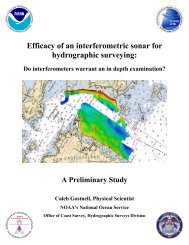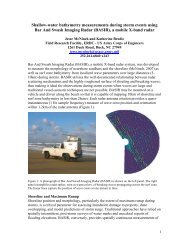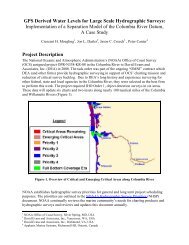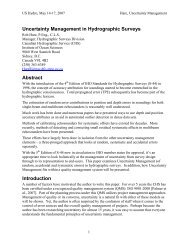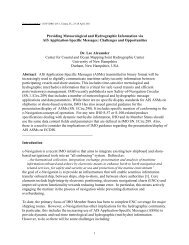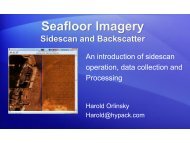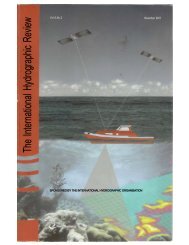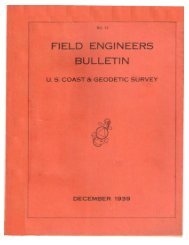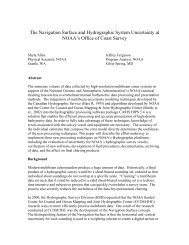A laser-based water level sensor and robust insulated and heated ...
A laser-based water level sensor and robust insulated and heated ...
A laser-based water level sensor and robust insulated and heated ...
Create successful ePaper yourself
Turn your PDF publications into a flip-book with our unique Google optimized e-Paper software.
A <strong>laser</strong>-<strong>based</strong> <strong>water</strong> <strong>level</strong> <strong>sensor</strong> <strong>and</strong> <strong>robust</strong> <strong>insulated</strong> <strong>and</strong><br />
<strong>heated</strong> multi-well stilling well system for ice-prone temperate<br />
<strong>and</strong> sub-arctic sub-arctic environments.<br />
Steve Forbes (presenter) (Director, Canadian Hydrographic Service Atlantic)<br />
Phillip MacAulay (Head, Tides <strong>and</strong> Currents CHS Atlantic) macaulayp@mar.dfo-mpo.gc.ca<br />
Chris Coolen (Multi-disciplinary Hydrographer CHS Atlantic)<br />
Fred Carmichael (Tidal ( Technician CHS Atlantic) )<br />
Sub-arctic, , ice-prone p<br />
environment<br />
Nain tide station, Labrador<br />
(on a nice day)<br />
Insulated, <strong>heated</strong>,<br />
multi-well stilling well<br />
Water <strong>level</strong> measurement<br />
systems/<strong>sensor</strong>s<br />
4<br />
3<br />
2<br />
1<br />
0<br />
data quality is only as good as<br />
collection systems<br />
R R<br />
A
Introduction<br />
• Tide gauges measure <strong>water</strong> <strong>level</strong>s (the obvious)<br />
• Uses of tide gauge data<br />
- Basic sounding reduction<br />
Hd Hydrography h [
CHS Atlantic’s Permanent Water Level Network<br />
(many are ice-prone)<br />
16 tide gauges, 000’s kms of coastline<br />
1430<br />
Long Term Sea Level (GLOSS)<br />
Multi-well Laser systems - 08<br />
New Multi-well Laser Sites - 09<br />
2145<br />
0065<br />
0365<br />
2000<br />
1805<br />
0490<br />
1700<br />
0491<br />
1680<br />
0612<br />
0665<br />
0755<br />
0990<br />
0905<br />
0835
Water <strong>level</strong> <strong>sensor</strong>s (no magic solution)<br />
Total error estimates ignoring stilling well effects<br />
(Perspective) Wharf thermal expansion, expansion order +/- +/ 5mm 5 mm<br />
$.2K $.5K $1K<br />
+/- ~5-10 cm +/- ~2-3 mm +/- ~2-3 cm<br />
1) Tide Board<br />
4<br />
2) Tape Drop: st<strong>and</strong>ard t d d<br />
device used to set relative<br />
<strong>sensor</strong>s, (<strong>sensor</strong>s with offsets)<br />
CHS <strong>sensor</strong>s<br />
$5K $.8K $1.5K $5K $5K<br />
+/- 1% +/- 1% +/- ~2-3 mm +/- ~1-2 cm<br />
+/- 1%<br />
~2-3 cm ~2-3 cm<br />
~2-3 cm<br />
3) Float <strong>and</strong> PPulley lle 4) Bubbler<br />
5) SSubmersible bmersible pressure press re 6) Laser <strong>sensor</strong>: 7) Radar <strong>sensor</strong>:<br />
CHS Legacy <strong>sensor</strong> Sutron continuous fast<br />
response bubbler<br />
<strong>sensor</strong> Spectre Sensor Dimetix DLS-B15<br />
pump<br />
P atm<br />
8) Acoustic <strong>sensor</strong>:<br />
Single 3 manual<br />
Sound speed<br />
measurement Mech chain <strong>and</strong> Water density Relatively untested<br />
variation<br />
2<br />
weight errors<br />
variation stilling well required<br />
C(t,h, …)<br />
1<br />
0<br />
Stilling gwell required q – R<br />
Stilling well Optional – O<br />
Relative Measurement – R (must be set relative to a known)<br />
Absolute Measurement – A (direct measurement)<br />
h<br />
o<br />
o<br />
o<br />
o<br />
P= wgh<br />
o 0 0 0<br />
P=wgh R, A R, R<br />
O, R O, R R, A<br />
Surface integration<br />
measurement<br />
bias<br />
O, A<br />
O, A<br />
Require stilling well in the<br />
presence of ice
The stilling well (a necessary evil)<br />
• Provides <strong>sensor</strong> protection <strong>and</strong> act as an analog mechanical<br />
filter via small dia entrance to large dia pipe (by area ~1/100 to 1/150)<br />
- Frequency dependent dependent filter filter, stills high high frequency frequency <strong>water</strong> motions<br />
• Filter parameters change with fouling/plugging example<br />
• Can be expensive to install <strong>and</strong> replace<br />
• Requires significant significant vertical vertical infrastructure infrastructure for for support<br />
support<br />
• To achieve true independence each <strong>sensor</strong> requires its own well<br />
• Known potential sources of error<br />
- <strong>water</strong> density inside well may may not not be/stay the same as outside resulting<br />
in different <strong>water</strong> surface <strong>level</strong> inside vs outside the well example<br />
- Inlet/exit flow non-linearity can introduce <strong>level</strong> offset under active<br />
wave conditions (in-out ( flow resistance hysteresis y effect) )<br />
• Cold weather issues<br />
- direct damage of well by ice (crushing) Nain well failures in 02 <strong>and</strong> 08<br />
- Ice formation in <strong>water</strong> in well (freezing) ( g)<br />
- ice/frost buildup above <strong>water</strong> along inside of well (not a frost-free appliance)<br />
- heating costs for un-<strong>insulated</strong> systems<br />
All persistent Nain problems
Stilling Well Filtering (a relative example)<br />
Data from three <strong>sensor</strong>s, , <strong>laser</strong>, , bubbler, , submersible pressure p <strong>sensor</strong>, ,<br />
in three wells, same location, one well experiencing brief period of minor plugging<br />
pressure<br />
<strong>sensor</strong><br />
bubbler<br />
<strong>laser</strong><br />
phase lag<br />
amplitude<br />
reduction<br />
Well developing minor plugging (dirty harbor): amplitude<br />
Well developing minor plugging (dirty harbor): amplitude<br />
reduction <strong>and</strong> phase lag develop for 20 min period wave energy,<br />
energy at longer tidal periods uneffected
Stilling Well Entrainment of Fresh Water<br />
Example, extreme rain event late in winter in the presence of significant pack<br />
ice leading leading to to deep deep penetration penetration of of fresh fresh <strong>water</strong> <strong>and</strong> infiltration into stilling well<br />
According to float <strong>and</strong> pulley <strong>sensor</strong><br />
<strong>water</strong> <strong>level</strong> inside well rises<br />
All three <strong>sensor</strong><br />
read the same<br />
Fresh <strong>water</strong><br />
infiltration<br />
WL According to bubbler <strong>and</strong> pressure<br />
<strong>sensor</strong> reading pressure at depth<br />
Water surface <strong>level</strong> potentially not equivalent<br />
inside <strong>and</strong> outside the well<br />
(error persistent until well is physically flushed)
Heated Multi-well stilling well<br />
Thermostat<br />
Heat tape<br />
line <strong>water</strong><br />
6)<br />
1) 14” 14 HDPE tough tough protective outer outer casing casing ( (~1 1 inch thick)<br />
2) 6” PVC Main well for <strong>laser</strong> float or float <strong>and</strong> pulley<br />
Thermocouple<br />
<strong>sensor</strong><br />
3) Three 2” satellite wells,<br />
3)<br />
– t two with ith stilling tilli orifices ifi for f a backup b k bubbler b bbl<br />
<strong>sensor</strong> <strong>and</strong> gnomen tape drop<br />
– one free flowing for a fast response pressure<br />
5)<br />
4)<br />
<strong>sensor</strong><br />
1)<br />
4) Two 1-1/4” heater tubes filled with environmentally<br />
2)<br />
friendly anti-freeze<br />
5) Insulation, marine grade slow expansion polyurethane<br />
2lb/ft foam foam from top of well to below low low <strong>water</strong><br />
<strong>water</strong><br />
6) 120 v self-regulating (heat output drops as temperature<br />
rises) submersible heat tapes (10 W/ft) in heater tubes,<br />
with additional thermostatic control<br />
(shut off at ~ 6 C)<br />
1) )<br />
4)<br />
Pros:<br />
• Heating distributed along full length of well<br />
prevents both ice <strong>and</strong> frost frost formation<br />
• Insulation reduces heating costs<br />
• Multi-well design requires only one installation<br />
for multiple truly independent <strong>sensor</strong>s<br />
5)<br />
3)<br />
2) 3)<br />
3)<br />
4)<br />
Low w
Well Construction Overview<br />
1) Assemble <strong>and</strong> align pipe bundle bundle using<br />
316 SS hose clamps<br />
2) Construct <strong>and</strong> fit foam spacers at predetermined<br />
(~ 28 inch) intervals along<br />
pipe bundle bundle, secure in place with<br />
polyurethane spray foam<br />
3) Drill 2 inch holes in outer HDPE pipe<br />
to correspond with mid points<br />
b between f foam spacers<br />
4) Slide pipe bundle into outer casing<br />
5) Spray in slow-expansion polyurethane<br />
foam thru 2 inch access holes starting<br />
starting<br />
at one end of pipe <strong>and</strong> working<br />
sequentially to other end. Use lots,<br />
bleeds past spacers filling all voids,<br />
excess exp<strong>and</strong>s exp<strong>and</strong>s out access holes<br />
Fully assembled 25 ft multi-well<br />
- Cost ~ $ 2.5-3 K<br />
- Weight ~ 3 - 400 lbs, easily<br />
t transported t d on l long trailer, t il possible ibl to t<br />
carefully man-h<strong>and</strong>le into place<br />
without heavy machinery<br />
2) 2)<br />
)<br />
1)<br />
4)<br />
3)<br />
5)
Laser Sensor<br />
• Dimetix DLS-B15 Laser (+/- 1.5 mm accuracy)<br />
• Adjustable <strong>laser</strong> <strong>level</strong>ing mount <strong>and</strong> <strong>level</strong>ing-in<br />
reference plate (<strong>laser</strong> 0 ref is to front face): <strong>laser</strong><br />
is <strong>level</strong>ed <strong>level</strong>ed in in from from bench bench-marks marks to ref plate<br />
• Sutron Xpert logger using st<strong>and</strong>ard RS232<br />
input/decoder software block (6 second sample<br />
repeat period, 1 minute average)<br />
• Laser Float: 1” PVC foam board, 5” diameter,<br />
rounded edges (spec grav ~ .6) floats ~8mm<br />
above <strong>water</strong> surface<br />
- Edges grooved to improve <strong>water</strong> shedding<br />
- Embedded rare-earth magnets for float<br />
placement <strong>and</strong> retrieval (see float tool)<br />
- Top p surface p painted to p prevent <strong>laser</strong> p penetration<br />
into PVC <strong>and</strong> to thus provide clear reflection<br />
• Potential Improvements<br />
- Thicker float (1-1/2 or 2 inch) greater above<br />
<strong>water</strong> ater height ~12-16 12 16 mm<br />
- Electrostatic paint application for smoother top<br />
surface (surface must be smooth over length<br />
scale of <strong>laser</strong> dot for data-spike-free operation)<br />
Ref plate<br />
Float placement tool<br />
steel disc with eye bolt
Weight g enters <strong>water</strong><br />
F+P Float sinks (data offset low)<br />
Weight enters<br />
<strong>water</strong><br />
Laser vs Float <strong>and</strong> Pulley<br />
(weight entering <strong>water</strong> error)<br />
Laser<br />
Fl Float t <strong>and</strong> d pulley ll (F+P)<br />
Chain <strong>and</strong> weight wet<br />
F+P Float time lag (data offset high)<br />
Weight exits<br />
<strong>water</strong>
Nain Installation (piling mount)<br />
Installing<br />
Stilling well<br />
Laser spot<br />
Laser Float<br />
(<strong>laser</strong> on)<br />
Heaters <strong>and</strong><br />
heater control<br />
Heater tube<br />
<strong>laser</strong><br />
Bubbler<br />
<strong>laser</strong><br />
Tape<br />
drop<br />
Tape<br />
drop<br />
Stilling<br />
well<br />
Pressure<br />
<strong>sensor</strong><br />
Heater tube
St John’s Installation (wharf mount)<br />
heater<br />
Tape<br />
Bubbler drop<br />
<strong>laser</strong><br />
hheater t<br />
<strong>laser</strong><br />
Pressure<br />
<strong>sensor</strong><br />
Tape<br />
drop
Nain Sensor Comparison<br />
Each <strong>sensor</strong> independent, in own stilling well<br />
Laser checked against g tape p drop p( (in own stilling g well) ) time-averaged g test ggood<br />
to +/- 1 to 3 mm<br />
Bubbler <strong>and</strong> pressure <strong>sensor</strong> least-squares calibrated to <strong>laser</strong> for slope (<strong>water</strong> density) <strong>and</strong> offset<br />
Errors between <strong>sensor</strong>s explainable <strong>based</strong> on stilling well behavior: pressure <strong>sensor</strong> in well with little<br />
stilling, bubbler exhibits minor spiking at ~15 min interval (software bug in auto-zero process,<br />
manufacturer to provide p fix )
Summary<br />
• Two example <strong>insulated</strong> <strong>and</strong> <strong>heated</strong> multi-well installations operational<br />
for 8 months: only minor teething issues experienced<br />
• Following multi-well installation heating costs at Nain Labrador<br />
significantly reduced<br />
reduced<br />
• Multi-well system relatively simple, inexpensive, <strong>and</strong> easy to construct<br />
<strong>and</strong> install: system <strong>robust</strong>ness, longevity <strong>and</strong> system maintenance<br />
issues still to be determined<br />
• Laser-float <strong>sensor</strong> accuracy appears stable at ~ 2-3 mm, further<br />
confirmation required but clearly better than a st<strong>and</strong>ard float <strong>and</strong><br />
pulley system: minor data-spiking (occasionally a few data spikes per<br />
day, easily cleaned) suspected source, float surface imperfections.<br />
Suggested solution, thicker float, better painted surface QC<br />
• Stilling well errors still a factor: a possible solution to counteract<br />
inside inside-outside outside <strong>water</strong> <strong>water</strong> density density generated generated errors errors is under consideration<br />
consideration



